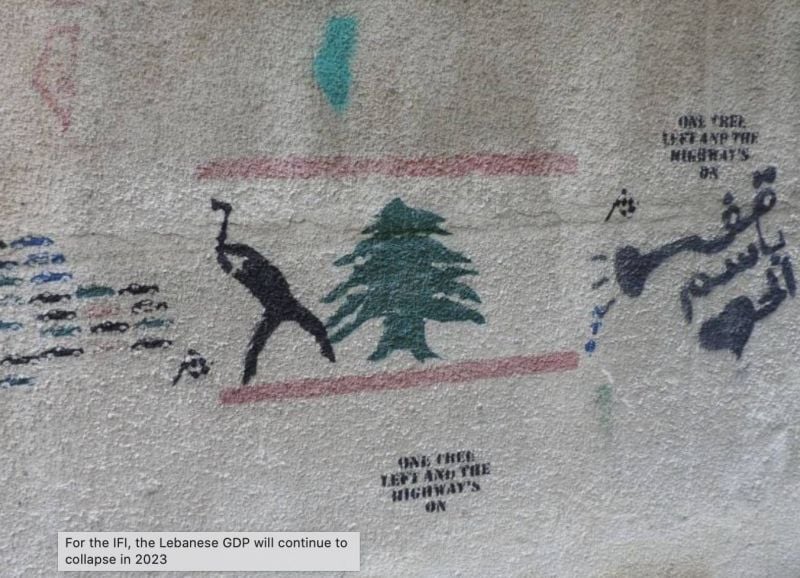
Graffiti on a wall in Beirut. (Credit: JRB)
The Lebanese crisis and the political class’s inaction in the face of the crippling challenges the country is facing has eliminated the increasingly cautious optimism of the Institute of International Finance (IIF) in its forecast on the Lebanese economy.
The organization, which brings together around 400 banks and financial companies worldwide, estimated in its latest report which was relayed this week by Bank Audi’s Lebanon Weekly Monitor, that Lebanon’s GDP is expected to fall by 7 percent in 2023, higher than the 6.5 percent fall of 2022 .
In value terms, the GDP is expected to reach $14.8 billion by the end of the year.According to an IIF report published in 2020, this number measured at $51.7 billion at the end of 2019.
The anticipated contraction over four years is therefore 70 percent.
While the IIF forecasts are close to those made recently by the World Bank in the fall (which it estimated at -5.4 percent in 2022), the latter institution has yet to present its forecasts for 2023, judging the level of uncertainty too high.
An International Monetary Fund delegation is due to visit Lebanon in the middle of the month to update its diagnosis of the country. It should be noted that official Lebanese estimates are very out of sync, with caretaker Prime Minister Najib Mikati announcing in December that Lebanese GDP had increased by 2 percent in 2022.
In terms of reasons, the IIF unsurprisingly cited the persistent political stalemate and the lack of reforms that have persisted almost a year after the signing of the staff-level agreement between the IMF and the Lebanese authorities. The latter had pledged to implement a number of preconditions to finalize a $3 billion IMF deal that would have been disbursed over four years.
Unifying the exchange rates that have been on the market since the beginning of the crisis, enacting a capital control law and another law to lift banking secrecy, or initiating steps for the debt restructuring process and the restructuring of its banking sector, are part of the list.
One year on, the Lebanese authorities have only passed a flawed law to lift banking secrecy and an unbalanced budget that came into effect ten and a half months late. The process of unifying exchange rates has begun, but it does not seem to be working, given that there are five rates that co-exists with the market rate (which has at this time surpassed 90,000LL to the dollar)
The parallel rates are as such: the Sayrafa rate (LL70,000); the Sayrafa rate applied to civil servants for salaries paid in March (LL45,400); the new customs dollar rate (LL45,000); the rate applicable to electricity bills for November and December 2022 (LL52,320, i.e., the old Sayrafa rate plus 20 percent); and finally, the new official peg of (LL15,000) imposed on Feb. 1 to replace the old one (LL1,507.5).
Considering the extent of damage caused to the formal economy, it is no surprise that the IIF describes the possibility of these reforms as a “miracle.”
The IIF predicts that inflation will continue to grow at triple-digit rates consistent with previous years (with an average inflation rate of 171.2 percent in 2022, according to official figures).
Furthermore, the IIF expects the dollar to rise above the LL110,000 mark, reflecting a 99-percent depreciation rate compared to the former official peg. This depreciation will result in an increase in the haircut on dollar deposits that are still illegally held in the banking sector.
The IIF also indicates that the Banque du Liban’s foreign exchange reserves, excluding the approximately $17 billion in gold at current prices and the $5 billion in Eurobonds that the government has yet to start repaying, are expected to decrease from $10.6 billion to nearly $6 billion in one year.
As a result of this deteriorating situation, the IIF predicts that an additional 200,000 Lebanese will leave the country in 2023, which is equivalent to the number of individuals that emigrated in 2022.
The IIF also highlights that, based on its estimates, smuggling to Syria accounted for around $3 billion out of the $19 billion worth of imports listed in 2022.
This phenomenon has been fueled by the belated adjustment of customs duties in Lebanon to reflect the actual exchange rate, the general increase in food and fuel prices and the porous nature of the country's borders.
This article was originally published in French in L'Orient-Le Jour. Translation by Sahar Ghoussoub and Joelle El Khoury.